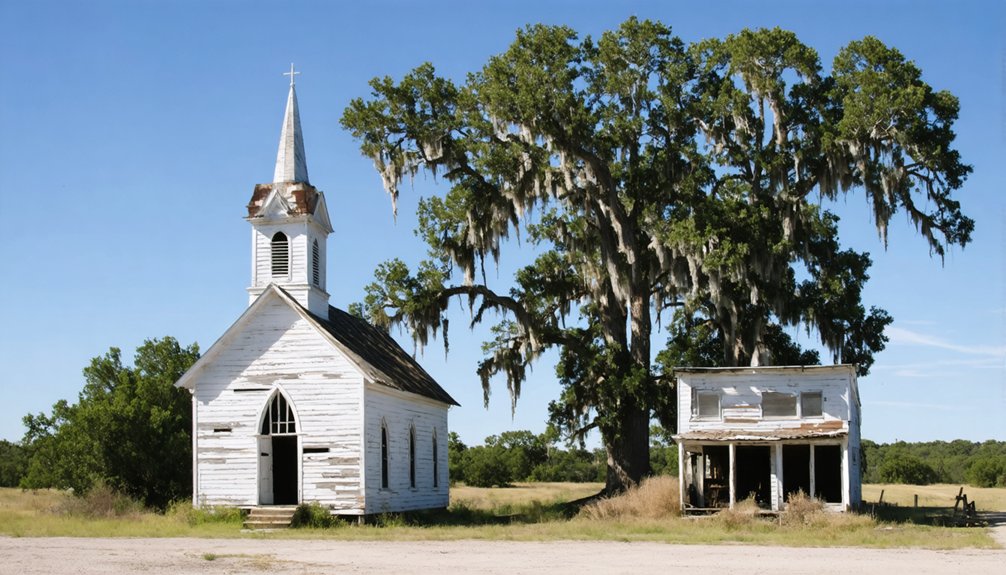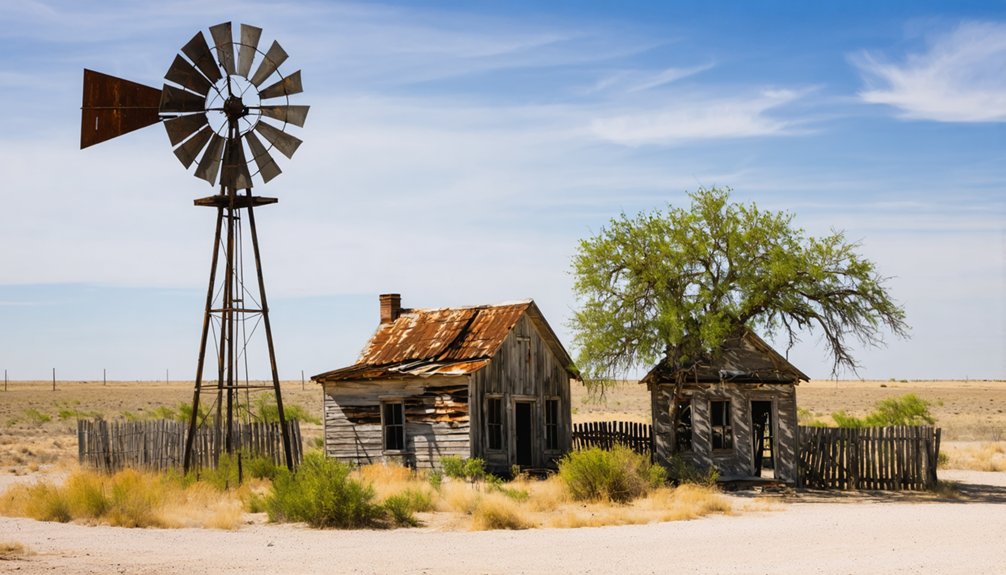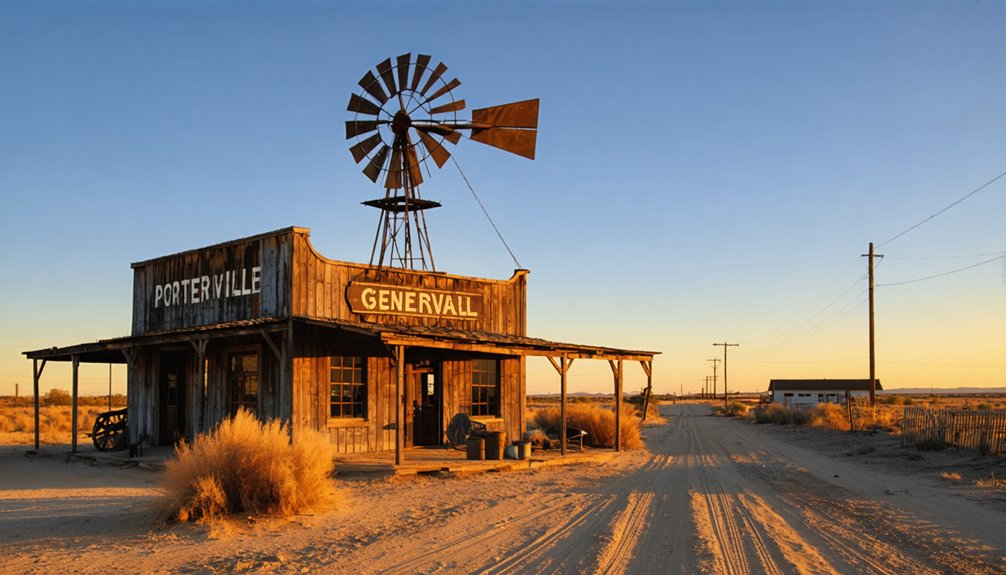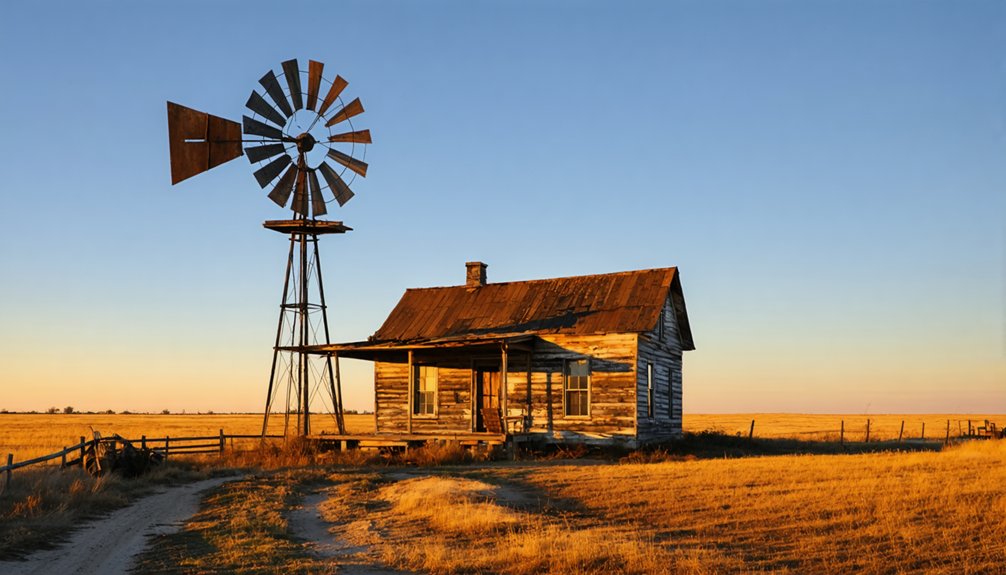You’ll find Porterville’s abandoned ruins about 25 miles northwest of Pecos, Texas. Dr. Phil Porter established this health colony and farming settlement in 1905, seeking to create a thriving community using the desert’s dry air for respiratory treatments. The town, initially named Juanita, featured a hotel, blacksmith shop, post office, and general stores. While Porter’s ambitious 10,000-acre irrigation project ultimately failed due to water scarcity, the town’s story reveals fascinating insights into early Texas frontier life.
Key Takeaways
- Porterville was established in 1905 by Dr. Phil Porter as a settlement 25 miles northwest of Pecos, Texas.
- The town initially thrived with essential services including a hotel, blacksmith shop, post office, and general stores.
- Water scarcity from the Pecos River led to the failure of an ambitious 10,000-acre irrigation project.
- The community relocated key structures including the church-school house to Mentone in 1931 due to declining population.
- Porterville became a ghost town due to environmental challenges, water shortages, and migration to larger regional centers.
The Vision of Dr. Phil Porter
While many settlers were drawn to West Texas for its opportunities, Dr. Phil Porter had bigger Porterville dreams. As the area’s physician and colony leader, he envisioned a thriving settlement where people could benefit from the dry desert climate’s therapeutic qualities. His health aspirations aligned perfectly with the promise of affordable farmland and abundant water resources.
You’ll find that Porter’s vision took shape as he helped establish essential community services. The settlement grew to include a hotel, blacksmith shop, post office, and general stores. The town was positioned about 25 miles northwest of Pecos, serving as a vital outpost for the region.
His ambitious irrigation project aimed to nurture 10,000 acres of farmland through a carefully planned ditch system. The combination of inexpensive land, health benefits, and agricultural potential seemed to position Porterville for success in the harsh West Texas environment. The town was established in 1905 in Texas, marking the beginning of Dr. Porter’s ambitious settlement project.
Origins in Early 20th Century Texas
Beyond Dr. Porter’s era, you’ll find Porterville’s true origins rooted in the early 1900s settlement patterns of West Texas.
The town, initially called Juanita, was officially platted on June 8, 1908, when it adopted its permanent name. You can trace the community’s foundation to the typical challenges faced by frontier settlements – establishing basic infrastructure like a post office and adapting to the semi-arid environment.
The early residents, primarily ranchers and farmers, built their lives around the modest but essential amenities of the time. Like many settlements that would later become oil boom towns, Porterville maintained a small but stable population supported by local agriculture and commerce. Similar to Thurber, the town utilized a company store system where workers were required to make their purchases.
Economic challenges began mounting as larger regional centers drew away resources and opportunities, setting the stage for its eventual decline.
Life in a Desert Health Colony
In Porterville’s early years, you’d find patients seeking relief from respiratory ailments through exposure to the dry desert air, which doctors believed could help cure tuberculosis and other lung conditions.
Your daily health routine would have centered around prescribed rest periods balanced with moderate outdoor activity, all while carefully managing exposure to the harsh Texas sun and extreme temperatures. Much like the early lumber camps documented in South Texas, residents had to create a self-sustaining community in harsh conditions.
Living in this isolated health colony meant you’d need to adapt to limited water supplies, sparse infrastructure, and a heavy reliance on imported goods for basic survival. The town ultimately failed when insufficient water supply from the Pecos River forced residents to abandon their settlement.
Desert Air Medical Benefits
Through the development of advanced air medical services, desert health colonies like Porterville gained essential access to lifesaving care despite their remote locations.
You’d find 24/7 emergency care through air transport services that could whisk you to specialized treatment centers, bypassing the region’s poor roads and vast distances. These flights offered critical care from highly trained medical teams during transit, improving patient outcomes for severe trauma, burns, and cardiac events. Valley AirCare’s fleet includes Learjet aircraft that can reach speeds over 500 mph for long-distance medical transport.
You’re getting more than just emergency evacuation – these services provided ICU-level care in the air, complete with advanced life support equipment and specialized medical crews. The bedside-to-bedside service ensured patients received continuous medical attention from their initial location to their final healthcare destination.
When you needed immediate access to tertiary hospitals or burn centers, air transport advantages meant the difference between life and death, especially during disaster response situations requiring rapid evacuation.
Daily Health Routines
Living in a desert health colony like Porterville meant following strict daily routines to maintain wellness despite harsh conditions and limited medical resources.
You’d rely heavily on community support and self-care practices, adapting traditional health strategies to the desert environment. Since professional medical care was scarce, barbers served as doctors for most health concerns. Teachers found creative ways to maintain educational health initiatives through TPT marketplace resources.
Key elements of your daily health routine would include:
- Maintaining rigorous daily hygiene despite water scarcity
- Engaging in physical labor during cooler hours to preserve strength
- Preparing locally available foods with careful attention to nutrition
- Taking afternoon rest periods to avoid heat exhaustion
- Participating in community gatherings for emotional wellbeing
Through shared knowledge and mutual assistance, you’d work with your neighbors to overcome the lack of professional medical care, drawing upon time-tested home remedies and preventive practices passed down through generations.
Surviving Harsh Conditions
While daily health routines helped residents endure life in Porterville, the harsh desert environment presented constant challenges that shaped every aspect of survival.
You’d find yourself constantly adapting to extreme heat, limited water resources, and minimal infrastructure. Desert survival meant dealing with problematic water supplies that damaged pipes until systems were upgraded in 2010, forcing you to rely on water trucked in from distant towns.
Your community’s resilience showed through creative solutions – spreading homes across the terrain to reduce resource competition, developing desert-appropriate farming methods, and maintaining strong social bonds for mutual support.
You’d participate in outdoor activities aligned with health practices while facing the reality that basic services were sparse, requiring self-sufficiency and cooperation with neighboring communities for essential resources.
The Wooden Church and Town Buildings

You’ll find the wooden church‘s original 1909 construction exemplified simple frontier architecture, with its practical wood frame design allowing for community gatherings in early Porterville.
The church’s 1931 relocation to Mentone preserved this essential piece of local history when oil discoveries shifted the area’s population center.
While the church survived as the oldest building in Loving County, Porterville’s other structures – including its hotel, blacksmith shop, and general stores – gradually fell into disrepair and disappeared entirely.
Church’s Original Construction Details
When the residents of Porterville constructed their original church in 1909, they created a multipurpose wooden structure that embodied the resourcefulness of early Texas frontier settlements.
You’ll find their construction techniques reflected a practical approach, using locally sourced timber and architectural simplicity to create a building that served multiple community needs.
The church’s fundamental design included:
- Simple rectangular floor plan adaptable for worship and schooling
- Large windows for essential natural lighting
- Single-story layout with practical pitched roof
- Basic wooden framing with minimal ornamentation
- Sturdy construction that withstood desert conditions
The building’s design prioritized functionality over form, allowing it to serve as a community hub, school, and place of worship.
This resourceful approach proved so effective that the structure remained viable enough for relocation to Mentone in 1931.
Relocation to Mentone Journey
The remarkable journey of Porterville’s wooden church building began in 1931, as the town’s dwindling population and failed farming ventures prompted a strategic relocation to nearby Mentone.
As part of carefully planned relocation strategies, you’d have witnessed the moving of three key structures: the post office, hotel, and most significantly, the cherished school-church house, which had served the community since 1909.
The mile-long journey northeast demonstrated remarkable community resilience, as residents worked to preserve their most important gathering places.
While records don’t specify the exact transportation method used, they likely employed period-typical horse-drawn wagons or flatbed trucks.
The wooden church building’s successful move to Mentone helped establish the new town’s identity, where it continued serving multiple congregations until being replaced by a brick school in 1935.
Surrounding Community Structures History
As Porterville emerged in 1905 under Dr. Phil Porter’s leadership, the town’s growth centered around key structures that defined its community.
You’ll find that agricultural impact drove the development, with irrigation systems supporting local farming and providing economic stability for construction projects.
The town’s community engagement was evident in the collective effort to build essential structures:
- Wood frame church constructed in 1909, now standing as Loving County’s oldest building
- Multi-purpose community building serving as both school and church
- Basic infrastructure including roads and town facilities
- Local businesses supporting town development
- Shared spaces for community gatherings and activities
These structures reflected the practical needs of early 20th-century Texas settlers, though most have now vanished except for the historic church, which you can still visit in Mentone.
Environmental Challenges and Hardships

Facing compounding environmental pressures, Porterville’s decline stems from a perfect storm of industrial pollution, water scarcity, and climate-driven extreme weather events.
You’ll find the town surrounded by petrochemical facilities emitting dangerous carcinogens like benzene and 1,3-butadiene, creating serious environmental justice concerns as cancer risks soar into the nation’s highest percentiles.
The town’s agricultural foundation has crumbled as aquifers run dry, with only about 50 years of water remaining in key reservoirs.
You’re witnessing the devastating impact of intensifying hurricanes and tropical storms, which have accelerated infrastructure damage and population displacement.
These environmental challenges have created a downward spiral, severely undermining economic sustainability as younger residents flee, leaving behind a shrinking community struggling against mounting ecological and health burdens.
The Path to Abandonment
Founded in 1905 by Michigan physician Dr. Phil Porter, Porterville’s path to abandonment resulted from multiple economic and environmental pressures.
Despite Dr. Porter’s grand vision for a thriving health colony, Porterville succumbed to harsh economic realities and environmental challenges.
The town’s initial promise as a health colony and agricultural settlement gradually eroded due to critical abandonment factors:
- Insufficient water supply from the Pecos River severely limited agricultural expansion and sustainability
- Failed irrigation efforts in harsh desert conditions forced farmers to relocate elsewhere
- 1930s oil discoveries shifted regional focus to Mentone, drawing away residents and businesses
- Lack of oil industry development within Porterville deepened its economic decline
- Deteriorating infrastructure, including the 1931 relocation of the town’s church to Mentone, marked the community’s final descent
Legacy in Loving County

Though Porterville itself faded into history, the town’s influence on Loving County endures through its significant contributions to the region’s development.
You’ll find Porterville’s legacy most visible in Mentone, where the relocated school-church building continues to serve the community. The town’s pioneering spirit lives on through the descendants of early settlers, like Lloyd Goodrich, who maintained his grandfather’s farming traditions, and Joe Renteria, who rose to County Commissioner.
While Porterville’s ambitious irrigation plans failed, the experience shaped Loving County’s economic focus toward successful ranching operations. The town’s community-driven approach to building infrastructure and social institutions established a foundation for civic engagement that influenced subsequent development in Loving County, making Porterville’s short-lived existence historically significant.
What Remains Today
As time has reclaimed the once-bustling settlement, Porterville’s physical remnants have dwindled to scattered ruins and weathered foundations across the West Texas landscape.
A remnants assessment reveals a neglected site where nature has steadily overtaken the abandoned structures.
During your site exploration, you’ll find:
- Roofless building shells slowly crumbling into the earth
- Faint traces of old foundations hidden beneath desert vegetation
- Possible remains of an old store or homestead, now barely recognizable
- Unpaved dirt roads leading to overgrown pathways
- No functional buildings or maintained infrastructure
Today, Porterville stands as a reflection of the transient nature of frontier settlements. Its ghostly remains draw only occasional visitors seeking glimpses of Texas history among the deteriorating ruins.
Historical Significance and Documentation
Despite its brief existence, Porterville’s historical record reveals a unique chapter in Texas settlement patterns, particularly exemplifying early 20th-century health-focused migration.
You’ll find limited primary sources documenting the town’s history, with most information pieced together from regional accounts and ghost town directories. The town’s historical documentation primarily centers on Dr. Phil Porter’s founding vision and the 1909 church building, which later became the oldest structure in Loving County after its relocation to Mentone in 1931.
Porterville’s ghost town significance lies in its representation of the challenges faced by early Texas settlers in harsh environments.
While you won’t find extensive municipal archives or census data, the town’s story contributes to understanding the broader narrative of failed settlements in resource-scarce regions of West Texas.
Frequently Asked Questions
What Became of Dr. Phil Porter After the Town’s Abandonment?
You won’t find records of Dr. Porter’s legacy or his descendants after Porterville’s decline, as historical documents don’t track his whereabouts or activities following the town’s abandonment in the early 1900s.
Were There Any Notable Deaths or Burials in Porterville’s Cemetery?
You won’t find much to write home about – historical records don’t reveal any notable burials in this cemetery. The cemetery history shows just two documented memorials on Find a Grave.
How Did Residents Obtain Drinking Water in This Desert Settlement?
You’d have relied on wells for water sourcing in this harsh desert environment, with drinking water likely being trucked in from Pecos when local supplies weren’t sufficient for desert adaptation.
What Was the Peak Population of Porterville During Its Existence?
While many Texas towns saw dramatic demographic changes, you’ll find Porterville’s historical significance peaked at 150 residents in 1892, before dwindling to just 12 people by the year 2000.
Did Any Businesses or Industries Operate in Porterville Before Abandonment?
You’ll find limited evidence of significant business activities beyond small-scale agriculture and possible wellness services from its health colony origins. The town’s economic decline stemmed from insufficient commercial development rather than industrial collapse.
References
- https://en.wikipedia.org/wiki/List_of_ghost_towns_in_Texas
- https://kids.kiddle.co/Porterville
- https://www.texasescapes.com/WestTexasTowns/LostTownsOfPecos.htm
- http://genealogytrails.com/tex/bigbend/loving/history_towns.html
- https://www.tshaonline.org/handbook/entries/porterville-tx
- https://www.texasescapes.com/WestTexasTowns/PortervilleTexas.htm
- https://portervillehistory.wordpress.com/2024/02/04/other-portervilles/
- http://www.txgenweb.org/research/landmarks/loving.htm
- https://discovertexasoutdoors.com/places/porterville-texas-a-once-promising-desert-settlement-with-a-fading-story/
- http://genealogytrails.com/tex/bigbend/loving/news_gossip.html



